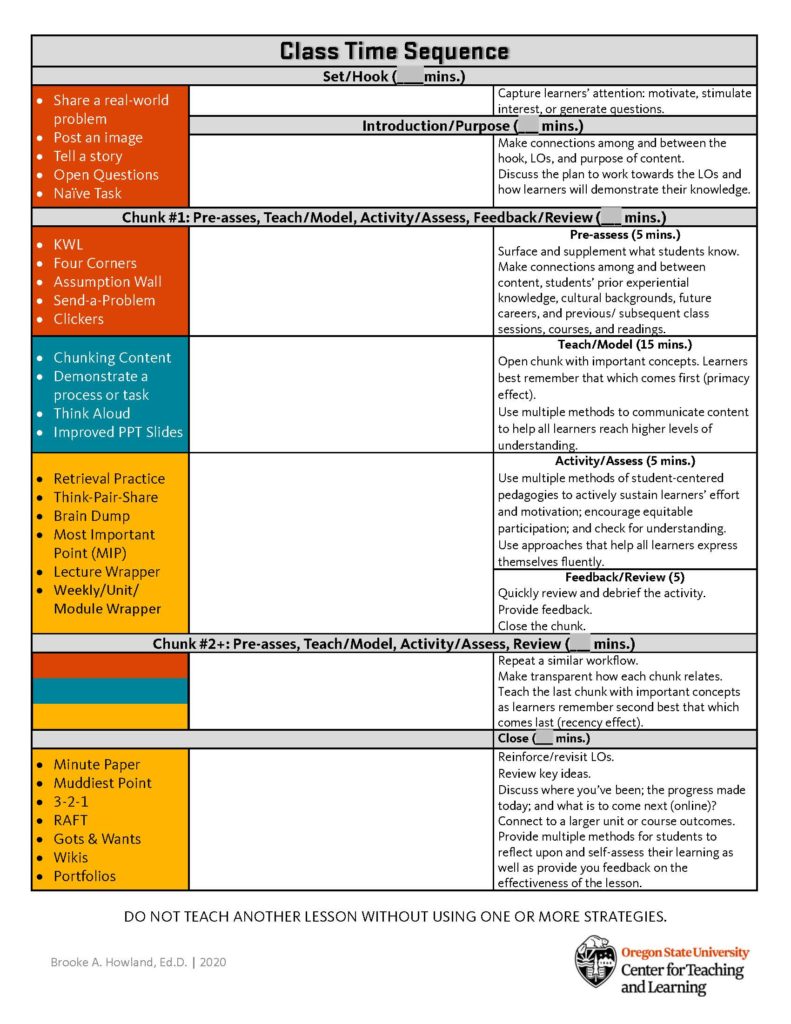
This post is the third post of my three-part UDL series. Post one, focused on Defining UD, DI, and UDL. Post two, Pedagogical Approaches for Implementing UDL provided principles, supporting research, and pedagogical approaches to support this framework. This final post, shares a lesson plan template along with a wealth of actionable strategies to use when teaching.
Intentional Lesson Planning & Strategy Integration

The application of UDL principles has been tied to increased student engagement, persistence, and retention. A UDL teacher intentionally plans for expected variability across learners by creating a flexible curriculum that amplifies natural abilities and reduces unnecessary barriers.
This UDL Lesson Plan Template is intended to support you in preparing for class sessions. It provides prompts to promote the integration of explicit instructional strategies as multiple methods to engage, teach, and assess learners. For some of the prompts, there are links taking you directly to a strategy card found in the new deck of CTL Instructional Strategies: Multiple Methods to Engage, Teach, and Assess. Each card provides details about and supporting research for the corresponding strategy.

The application of UDL principles has been tied to increased student engagement, persistence, and retention. A UDL teacher intentionally plans for expected variability across learners by creating a flexible curriculum that amplifies natural abilities and reduces unnecessary barriers.
Strategies are often considered scaffolds. Like scaffolds in construction, they serve as support, lifting workers to achieve something that otherwise wouldn’t be possible. Scaffolding means helping learners to do what they cannot do alone at first. Faculty who use scaffolds slowly remove them with intent to build independent learners. However, research shows that when strategies begin to disappear that learners’ academic achievement, confidence, and excitement for school also diminish. Therefore, it is important to overtly teach the What? (or high-end overview that defines the strategy); the Why? (describes the rationale for doing the strategy); and the How? (lists the steps or process of the strategy). This transparency supports learners to independently choose when, why, and how to use these strategies when in need and are also included as part of the Strategy Cards.
Although a lesson template and strategy routines are shared, it is important to stress that teaching is not a recipe. Inclusivity is a mindset. Universal Design for Learning is a mindset. These resources are intended to be modifiable guides, or scaffolds, to help meet your needs.
So new it hasn’t yet made it to the printer!
For a deeper dive, check out the entire deck of CTL Instructional Strategies: Multiple Methods to Engage, Teach, and Assess! Feel free to download this pdf or enter our drawing to win a free deck! Leave a relevant comment, connection, or question below to be entered! Three random winners will be selected! Good luck!
Resources
- CAST (2018). Universal Design for Learning Guidelines version 2.2. Retrieved 5/25/2020 from http://udlguidelines.cast.org
- College STAR. Introduction to Universal Design for Learning. Retrieved 1/27/2020 from https://www.collegestar.org/universal-design-for-learning
- Field, S., Sarver, M. D., & Shaw, S. F. (2003). Self-Determination: A Key to Success in Postsecondary Education for Students with Learning Disabilities. Remedial and Special Education, 24(6), 339–349.
- Fuchs D, Mock D, Morgan P, Young C. Responsiveness-to-intervention: Definitions, evidence, and implications for the learning disabilities construct. Learning Disabilities Research & Practice. 2003;18:157–171.
- Getzel, E. (2008). Addressing the persistence and retention of students with disabilities in higher education: Incorporating key strategies and supports on campus. Exceptionality, v16(4), 207-219.
- Meyer, Rose, & Gordon, (2014). Universal Design for Learning: Theory and Practice. CAST Professional Publishing.
- Moore, J. C. & Fetzner, M. J. (2009). The road to retention: A closer look at institutions that achieve high course completion rates. Journal of Asynchronous Learning Networks, v13(3). 3-22.
- Novak, K. (2016). UDL in the Cloud!. CAST Professional Publishing.
- Pearson, P. D. (1982). A context for instructional research and reading comprehension. (Technical Report No. 230). Urbana: University of Illinois Center for the Study of Reading.
- UDL on Campus. Retrieved 5/1/2020 from http://udloncampus.cast.org/home

Brooke Howland is the associate director of the Center for Teaching and Learning at Oregon State University. She received her B.A. and M.A. in Elementary Education with an ESL endorsement from the University of Northern Colorado and earned her Ed.D. in Teacher Education in Multicultural Societies from the University of Southern California. Her scholarly expertise is in teacher development and curriculum design. Prior to working at OSU, Dr. Howland taught in the School of Education for University of Southern California; University of California, Irvine; and currently teaches at University of California, Los Angeles.

Leave a Reply